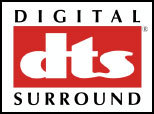Hercules Fortissimo III 7.1 and Digifire 7.1
DTS
DTS, for Digital Theater System, was introduced by Steven Spielberg with the release of "Jurassic Park" in 1993. So far, this standard applies more to the big screen and is only just beginning to be used in the private home. It too is 5.1, with sound is coded over 6 channels like it is in Dolby Digital. There are now many DTS-compatible systems around like the sound cards which can decode the standard by software. However, while DTS quality is undeniable, and even a bit better than Dolby, remember no movie comes out in DTS alone and Dolby is considered as a digital sound standard and DTS is not.
The main feature of DTS is that its coding system favors sound quality over disk space. So a DTS sound track codes in 24 bits instead of the 18 bits with Dolby. Compression uses a dynamic process where the compression rate varies with the amount of sound to encode. This rate ranges from 1:1 to 40:1 and generally results in better sound quality than Dolby Digital with an average rate of 1.5 Mb/s. The main drawback is obviously that the sound track takes up much more space (about three times as much) than a Dolby one. So DVDs coded in DTS can only have one language and a limited number of bonuses. Until recently, very few DVDs had a DTS band, but there are a lot more around now owing to the quality advantage this system has over Dolby Digital.
This quality advantage is due mainly to the way DTS encodes dynamically, but also to other factors, such as the fact that Dolby Digital mixes the channels above 15 kHz at 448 kb/s and above 10 kHz at 384 kb/s. This means Dolby Digital can reduce the space needed for the sound track on a DVD and retain a maximum of bandwidth at high output, but to the detriment of overall quality. DTS encoding never mixes the channels. This remark is not intended to kindle an argument over Dolby and DTS, just to show that each format has opted for different encoding systems. Dolby Digital goes for disk space and bandwidth while DTS prefers quality above all.
The DTS quality advantage also applies in 6.1 and 7.1 because only the DTS ES standard has discrete encoding on the sixth channel, meaning independent of the other surround channels and integrated during recording (on at least five sound effects mikes). But be warned: movies encoded in DTS ES Discrete are as yet few and far between and what you mostly find is a DTS ES Matrix track which has a rear center channel matrixed into the left and right surrounds as in Dolby Digital EX. So for the time being, there is only one true 6.1 sound system standard and it is not exactly mainstream.
Get Tom's Hardware's best news and in-depth reviews, straight to your inbox.
Current page: DTS
Prev Page Dolby Digital Next Page Fortissimo III 7.1 And Digifire 7.1: Technical Data

